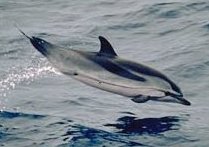| Stenella Temporal range: Neogene–Present PreꞒ Ꞓ O S D C P T J K Pg N | |
|---|---|

| |
| Striped dolphin | |
| Scientific classification | |
| Domain: | Eukaryota |
| Kingdom: | Animalia |
| Phylum: | Chordata |
| Class: | Mammalia |
| Order: | Artiodactyla |
| Infraorder: | Cetacea |
| Family: | Delphinidae |
| Subfamily: | Delphininae |
| Genus: | Stenella Gray, 1866 |
| Type species | |
| Steno attenuatus Gray, 1846 | |
| Species | |
|
S. attenuata | |
Stenella is a genus of marine mammals in Delphinidae, the family informally known as the oceanic dolphins.
Species
Currently, five species are recognised in this genus:
| Image | Common Name | Scientific name | Distribution |
|---|---|---|---|
 |
Pantropical spotted dolphin | S. attenuata | eastern Pacific Ocean |
 |
Atlantic spotted dolphin | S. frontalis | tropical areas of the Atlantic Ocean |
 |
Spinner dolphin | S. longirostris | Pacific Ocean |
 |
Clymene dolphin | S. clymene | Atlantic Ocean |
 |
Striped dolphin | S. coeruleoalba | North and South Atlantic Oceans, including the Mediterranean |
S. rayi was a species of this genus found in North Carolina, in the early Pliocene.
The common name for species in this genus is the "spotted dolphins" or the "bridled dolphins". They are found in temperate and tropical seas all around the world. Individuals of several species begin their lives spotless and become steadily more covered in darker spots as they get older.
The genus name comes from the Greek stenos meaning narrow. It was coined by John Gray in 1866 when he intended it as a subgenus of Steno. Modern taxonomists recognise two genera.
The clymene dolphin (S. clymene) is the only confirmed case of hybrid speciation in marine mammals, descending from the spinner dolphin (S. longirostris) and the striped dolphin (S. coeruleoalba).
Stenella dolphins tend to be more active during nighttime and spend their daytime resting. Although these dolphins are supposed to spend 60% of their daytime resting, they happen to be exposed to human activities for 80% of their day. These patterns of sleep deprivation can have negative impact on their resting habit and leads to decline in their population size.
References
- Wilson, D. E.; Reeder, D. M., eds. (2005). Mammal Species of the World: A Taxonomic and Geographic Reference (3rd ed.). Johns Hopkins University Press. ISBN 978-0-8018-8221-0. OCLC 62265494.
- ^ Tinker, Spencer Wilkie (1988). Whales of the World. Brill Archive. p. 310. ISBN 9780935848472.
- ^ Klinowska, Margaret; Justin Cooke (1991). Dolphins, Porpoises and Whales of the World. IUCN. p. 429. ISBN 9782880329365.
- Walker, Ernest Pillsbury; Ronald M. Nowak; John E. Heyning; Randall R. Reeves; Brent S. Stewart; John E. Heyning; Randall R. Reeves; Brent S. Stewart (2003). Walker's Marine Mammals of the World. JHU Press. p. 264. ISBN 9780801873430.
- Bianucci, Giovanni (May 2013). "Septidelphis morii, n. gen. et sp., from the Pliocene of Italy: new evidence of the explosive radiation of true dolphins (Odontoceti, Delphinidae)". Journal of Vertebrate Paleontology. 33 (3): 722–740. Bibcode:2013JVPal..33..722B. doi:10.1080/02724634.2013.744757. ISSN 0272-4634.
- Amaral, Ana R.; Lovewell, Gretchen; Coelho, Maria M.; Amato, George; Rosenbaum, Howard C. (2014). "Hybrid Speciation in a Marine Mammal: The Clymene Dolphin (Stenella clymene)". PLOS ONE. 9 (1): e83645. Bibcode:2014PLoSO...983645A. doi:10.1371/journal.pone.0083645. PMC 3885441. PMID 24421898.
- Tyne, Julian A.; Christiansen, Fredrik; Heenehan, Heather L.; Johnston, David W.; Bejder, Lars (2018). "Chronic exposure of Hawaii Island spinner dolphins (Stenella longirostris) to human activities". Royal Society Open Science. 5 (10): 171506. doi:10.1098/rsos.171506. ISSN 2054-5703. PMC 6227997. PMID 30473795.
| Odontocete genera | |||||||||||||||||||||||||||||||||||||||||
|---|---|---|---|---|---|---|---|---|---|---|---|---|---|---|---|---|---|---|---|---|---|---|---|---|---|---|---|---|---|---|---|---|---|---|---|---|---|---|---|---|---|
| |||||||||||||||||||||||||||||||||||||||||
| |||||||||||||||||||||||||||||||||||||||||
| |||||||||||||||||||||||||||||||||||||||||
| |||||||||||||||||||||||||||||||||||||||||
| Taxon identifiers | |
|---|---|
| Stenella | |
This Cetacean-related article is a stub. You can help Misplaced Pages by expanding it. |